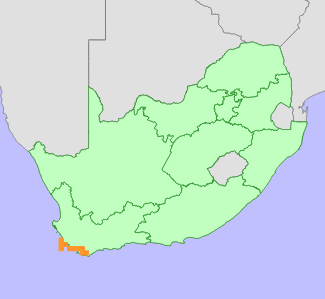|
Scientific Name | Disa venusta Bolus |
Higher Classification | Monocotyledons |
Family | ORCHIDACEAE |
Synonyms | Disa lacera in sense of Schltr., not of Sw. (misapplied name), Herschelia venusta (Bolus) Kraenzl., Herschelianthe venusta (Bolus) Rauschert |
National Status |
Status and Criteria | Vulnerable B1ab(ii,iii,iv,v) |
Assessment Date | 2012/08/31 |
Assessor(s) | L. von Staden & D. Raimondo |
Justification | EOO 2920 km², between seven and 10 remaining locations continue to decline due to ongoing habitat loss and degradation due to coastal development, lack of fire, and competition from alien invasive plants. |
Distribution |
Endemism | South African endemic |
Provincial distribution | Western Cape |
Range | Cape Peninsula to Bredasdorp. |
Habitat and Ecology |
Major system | Terrestrial |
Major habitats | Peninsula Sandstone Fynbos, Overberg Sandstone Fynbos, Kogelberg Sandstone Fynbos, Elim Ferricrete Fynbos, Hangklip Sand Fynbos, Cape Flats Sand Fynbos |
Description | Damp, sandy areas mostly below 450 m. |
Threats |
| Development of suburbs on the Cape Flats caused past decline, and currently subpopulations are declining due to rapid coastal development around Betty's Bay, Kleinmond and Hermanus. Fire exclusion due to increasing fragmentation of lowland coastal areas means that even subpopulations surviving habitat destruction will eventually become locally extinct. A subpopulation that formerly occurred at Kenilworth Racecourse has been lost due to prolonged fire exclusion.
Pine plantations have lead to the loss of large populations on the Steenberg, and only isolated individuals remain. Clearing of plantations might restore population numbers. Invasive acacias are also threatening subpopulations between Betty's Bay and Hermanus. |
Population |
Disa venusta flowers only in response to fires, and is rarely seen. It is known from numerous historical records, but is now nearly locally extinct on the Cape Flats and Cape Peninsula, where only a few plants survive on the Steenberg Plateau, an area where the species was reported to be common in the 1940s. Recent collections are scarce, and Linder (1981) reported never recording this species in the wild. It is estimated that between five and eight subpopulations remain. Where recorded, subpopulations are small, consisting of fewer than 50 plants.
|
Population trend | Decreasing |
Notes |
| A very disjunct collection from the Hogsback area in the Eastern Cape have been included with this species in the past, however, several slight morphological differences make the identification of this specimen as Disa venusta problematic (Linder 1981). The relationships of Disa venusta, Disa hians and Disa barbata are problematic and still needs to be resolved (Liltved and Johnson unpubl.). |
Assessment History |
Taxon assessed |
Status and Criteria |
Citation/Red List version | | Disa venusta Bolus | EN B1ab(ii,iii,iv,v) | 2012.1 | | Disa venusta Bolus | EN B1ab(ii,iii,iv,v) | Raimondo et al. (2009) | | Disa venusta Bolus | Lower Risk - Near Threatened | Victor (2002) | | Herschelianthe venusta (Bolus) Rauschert | Vulnerable | Hilton-Taylor (1996) | |
Bibliography |
Hilton-Taylor, C. 1996. Red data list of southern African plants. Strelitzia 4. South African National Botanical Institute, Pretoria.
Liltved, W.R. and Johnson, S.D. Unpublished. The Cape Orchids - Wild orchids of the Cape Floral Kingdom.
Linder, H.P. 1981. Taxonomic studies in the Disinae. VI. A revision of the genus Herschelia. Bothalia 13(3 & 4):365 - 388.
Linder, H.P. and Kurzweil, H. 1999. Orchids of southern Africa. A.A. Balkema, Rotterdam.
Raimondo, D., von Staden, L., Foden, W., Victor, J.E., Helme, N.A., Turner, R.C., Kamundi, D.A. and Manyama, P.A. 2009. Red List of South African Plants. Strelitzia 25. South African National Biodiversity Institute, Pretoria.
Victor, J.E. 2002. South Africa. In: J.S. Golding (ed), Southern African plant Red Data Lists. Southern African Botanical Diversity Network Report 14 (pp. 93-120), SABONET, Pretoria.
Victor, J.E. and Dold, A.P. 2003. Threatened plants of the Albany Centre of Floristic Endemism, South Africa. South African Journal of Science 99:437-446.
|
Citation |
| von Staden, L. & Raimondo, D. 2012. Disa venusta Bolus. National Assessment: Red List of South African Plants version 2024.1. Accessed on 2025/10/30 |
 Comment on this assessment
Comment on this assessment


